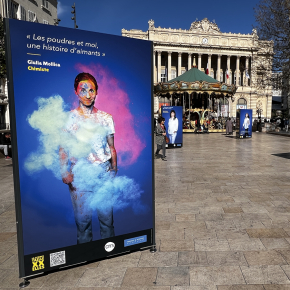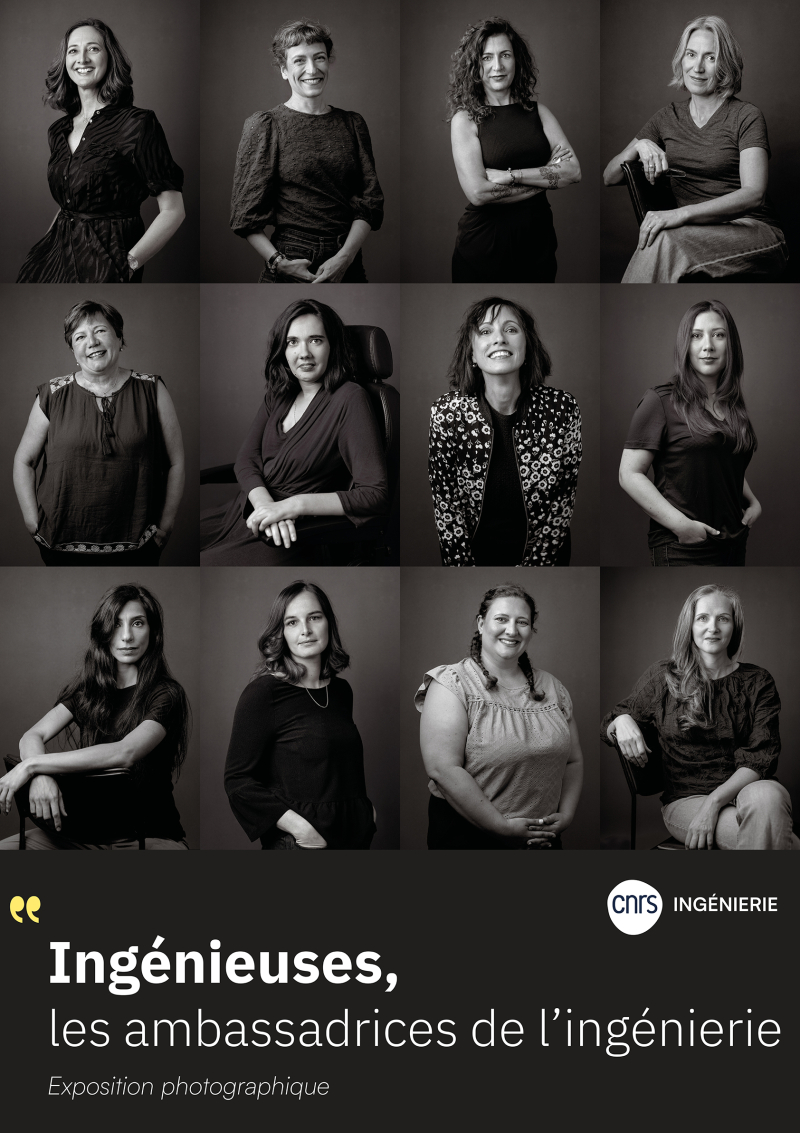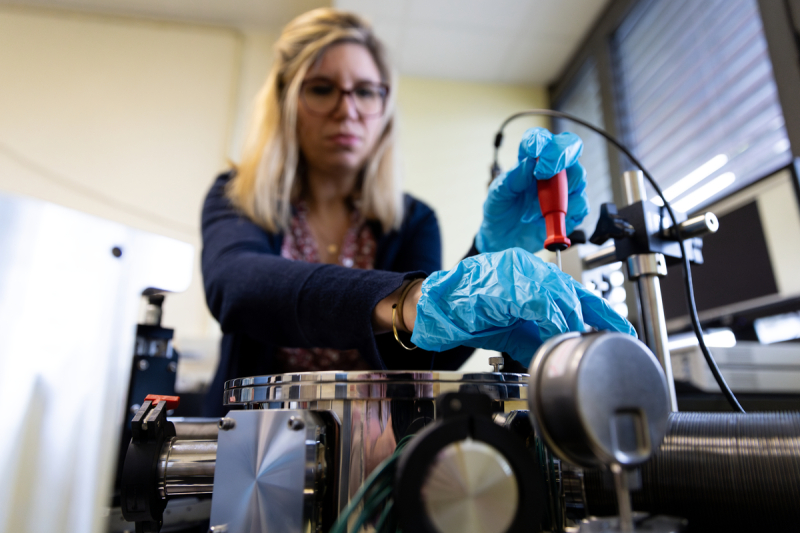Women in science in the spotlight at the CNRS
As the 'La Science taille XX elles' event launches its eighth edition seven years after the first, CNRS Engineering is also inaugurating 'Ingénieuses', a new travelling photographic exhibition.
At the start of this autumn, the CNRS is continuing to honour women in science. On September 12th in Montreuil (Seine-Saint-Denis), two of its Regional Offices in the Paris region launched the new edition of the photographic exhibition 'La Science taille XX elles'1 , produced in collaboration with the Femmes & Sciences association. On October 1st, CNRS Engineering, one of the organisation's ten Institutes, unveiled the 'Ingénieuses2 ' exhibition at the launch of the current thematic Year of Engineering. Also, on October 15th, the book 'Les filles sont parfaites pour les sciences' (Girls are perfect for science, publisher – MKF) will be published. This book pushes the boundaries of our imaginations and aims to change our view of the place of girls in scientific careers.
Renewing the image of women in science
158. This is the number of female researchers, engineers and technicians who have been photographed in the eight editions of 'La Science taille XX elles' since the exhibition began in Toulouse. However, as Isabelle Vauglin, the vice-president of Femmes & Sciences, points out "'Science taille XX elles' isn't just an exhibition, it's also an opportunity for teachers to invite each ambassador to visit their schools at least twice a year to talk to pupils about their jobs, careers and the diversity of scientific fields". Through the exhibition itself and classroom presentations of this kind, it is estimated that the programme reaches tens of thousands of pupils every year from a cohort of 700,000 to 800,000. This is in addition to the 20,000 pupils (girls and boys alike) whose awareness of this issue is raised annually by Femmes & Sciences' own activities. As well as these figures in schools, the exhibitions have also been a success in the media. The vastness of China led to the Chinese event run at the end of 2024 breaking all attendance records with over 150,000 visitors in Beijing and Guangzhou!
All of which confirms the very real societal impact 'La Science taille XX elles' has had with the exhibition undeniably helping to change perceptions of scientists at its level. Anne Haguenauer is the communications officer at the CNRS Provence & Corsica Regional Office in charge of organising a Marseille event in 2024 and joint editor of 'Les filles sont parfaites pour les sciences' with Isabelle Vauglin. She explains the importance of female role models thus: "If you ask secondary school pupils to describe a scientist, you get the typical portrait of an older white man in a white coat and glasses working in a laboratory. Even despite ourselves, these stereotypes are ingrained in our imagination because of all the representations we've encountered throughout our lives. And with good reason, as it's been estimated that out of 3500 gendered characters featuring in school textbooks, only 1 in 5 are women. In this context, this exhibition offers young girls other ways of imagining themselves, especially because it’s a travelling event." So, a change in the way we actually imagine women in science. "'Science taille XX elles' has renewed the representations of women scientists who, until now, had been exclusively portrayed through the quasi-unique model of Marie Curie, an isolated genius and so a bit difficult for young girls to relate to", insists Isabelle Vauglin. "Contemporary women scientists are brilliant, accessible women who work in a wide variety of fields in both the public and private sectors. They've got hobbies, a family life if and when they want and an exciting career throughout their lives".
Making scientific representations more inclusive and gender-balanced is even more vital because these really do have a tangible impact on the attractiveness of scientific careers. The effects of this have been observed since the 2019 'Blanquer reform' of the baccalaureate named after France's Minister of Education of the time. This reform gave secondary school students the freedom to choose their options instead of following a compulsory core curriculum with the result that 41% of girls currently choose a course without exact sciences in their final year. However, this drastic reduction in the initial pool of pupils automatically leads to a reduction in the number of female university students in scientific fields. "17% of girls were admitted to the École Polytechnique in 2024, compared to 23% in 20211 . This means 50% of sixteen-year-old girls have already given up on a career in technology or digital subjects2 even though these are the jobs of the future, today and tomorrow", laments Anne Haguenauer.
To counter this dynamic and encourage more young girls to choose a scientific career, the two Parisian Regional Offices and Femmes & Sciences are joining forces and continuing to offer new local editions of 'La Science taille XX elles' which reflects their strong and lasting collaboration to advancing gender equality in science. After the Île-de-France Villejuif and Paris-Centre Regional Offices' event, the Lille exhibition will open in early 2026 and will be followed next spring by a Loire event between Angers, Le Mans and Nantes. In total, no fewer than 10 Regional Offices and a CNRS Office abroad have now been involved in 'La Science taille XX elles' which the Marseille communications officer calls a "a truly structuring action by the CNRS for gender equality".
Inspiring young girls
While 'La Science taille XX elles' is taking a retrospective look back, CNRS Engineering is also launching, as part of the Year of Engineering, a new forward-looking scientific outreach initiative to promote the place of women in what is another very male-dominated discipline – engineering. Following an internal survey at the Institute, Hélène Barrès, its new gender equality officer, estimated that women only represent 24% of the workforce which is one of the lowest rates among the ten CNRS Institutes. Conversely, they are employed in the majority of administrative positions in research laboratories. The low number of women in science is perhaps likely to drop further as a result of the Blanquer reform as Hélène Barrès explains with concern. "Generations of female engineers will retire in the next ten years. The issue of the initial pool is already apparent. There's a real risk of stagnation or even an actual decline in the number of women in the exact sciences". This is particularly the case in engineering, where the erroneous masculine image of such professions remains likely to deter many young women.
Nonetheless, the gender equality officer remains hopeful. "The situation in France may be worrying but it's not a foregone conclusion". To counterbalance these overly masculine representations of engineering, the Institute has launched 'Ingénieuses', a photographic exhibition inspired by 'La Science taille XX elles'. Unlike the latter which is colourful in nature, the twelve 'ingenious women' have been portrayed in black and white and without staging for the sake of realism. The aim is to inspire young girls by highlighting the broad diversity of ages, nationalities, professions (the 'ingénieuses' are engineers, technicians and administrative staff) and even bodies (two have disabilities) of women in science. "This exhibition shows us the profession of the 'ingénieuses', their commitment and their career paths. We hear their voices. Each portrait is an encounter, a form of recognition and a source of inspiration for anyone still hesitating about going into these careers", explains the gender equality officer. As well as the inaugural exhibition and its travelling events, the 'ingénieuses' will visit middle and high school classrooms throughout France. "In this way, we're preparing the PhD students whose research will be needed in ten years' time", says Hélène Barrès.
The 'Ingénieuses' event marks the first stage of the action plan for gender equality at CNRS Engineering in the framework of the broader CNRS 2024-2026 plan for professional equality. Along with this scientific outreach initiative, the institute is bolstering and expanding its network of gender equality officers across all its 119 units to help drive a profound change in laboratory culture. The institute is also implementing various measures to encourage support for women in engineering throughout their careers, particularly as regards promotions and reaching positions of responsibility, along with support for going on or coming back from maternity leave which is a frequent point of divergence between female and male careers. Finally, CNRS Engineering is planning to provide €40,000 in annual funding to support laboratories in promoting gender equality.
Towards affirmative action?
However enthusiastic Hélène Barrès, Anne Haguenauer and Isabelle Vauglin may be about the photographic exhibitions they have worked on, they share the view that promoting female role models is not in itself enough to achieve true gender parity in science. Alongside this necessary work on people's perceptions, all three advocate for strong measures such as positive discrimination in favour of women, for example in the form of mandatory recruitment and promotion quotas. "The issue of quotas is complicated because it calls into question the criteria for scientific excellence and the reasons for recruiting someone. But really, there's no valid reason not to have the same proportion of women recruited as there are women candidates. Quotas would also help counter the 'glass ceiling' and ensure we don't systematically settle for there not being many women at the highest levels and in positions of responsibility", observes the vice-president of Femmes & Sciences. "We've seen in politics that incentives on their own don't work. Quotas were a necessary step towards diversifying the political workforce", argues Anne Haguenauer. This point is echoed by CNRS Engineering's gender equality officer. "Affirmative action is a necessary step in diversifying research if we want to maintain proportions in recruitment and promotions that are equivalent to the existing pool".
Quotas or not, the CNRS has already implemented a number of measures to promote the recruitment and promotion of female researchers and engineers. These include raising awareness of gender bias among the juries of the National Committee's sections, developing a network of gender equality officers among the disciplinary committees or applying the principle of 'cascading' promotions by which the proportion of women promoted is equal to or greater than the proportion of women eligible for promotion. And the results are clearly there. The 2021-2023 action plan saw a higher proportion of women recruited to scientific jobs in the 2020-2022 period (39.4% of recruits) than in the 2017-2019 period (36.3%). Alongside this, the glass ceiling is lowering with the proportion of female research professors moving up from 30.1% in 2019 to 31.7% in 2022 and the proportion of female unit directors increasing from 22.4% to 25%. The route to full parity is not a long, tranquil river trip but the CNRS has nevertheless set out in exactly that direction.
Further reading
Les filles sont parfaites pour les sciences. La prevue en 48 portraits de femmes (The proof in 48 portraits of women), edited by Isabelle Vauglin and Anne Haguenauer and published by MKF in October 2025.
Women scientists to be showcased on the Eiffel Tower soon
As a complement to all these communication initiatives, in early September the company that runs the Eiffel Tower and Femmes & Sciences submitted a report to the Mayor of Paris that advocates for the names of 72 female scientists to be inscribed on the first floor of the Eiffel Tower, a project which the CNRS is also contributing to. These women will balance out the 72 names of male scientists Gustave Eiffel selected when the tower was built. This is a way of recognising the legacy of women in science and encouraging more women to go into research professions.




